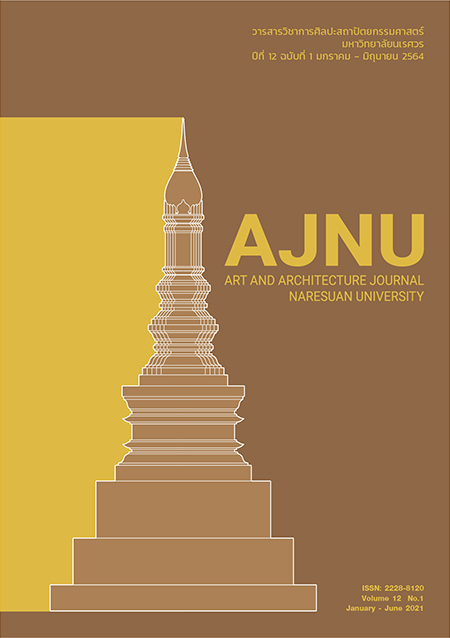A landscape design for development and value added of cultivated banana planting for nong pho village in Chee wuek, Nakhon ratchasima province
Main Article Content
Abstract
This research is aimed to study the landscape in architectural design for the community and improve the sustainable development to add value of banana products in the Nong Pho village, which is in Chee Wuek sub-district, Kham Sakaesaeng district, Nakhon Ratchasima province, is the pilot study area for landscape architectural design techniques integrated with community participation method to make knowledge for the strong and sustainable community.
There is the research methodology to collecting data such as surveying the physical environment area around the sample houses, interviewing with representative participant, and in-depth interviews with the experts for consultation and suggestions about landscape design and development in order to promote and add value for cultivated banana production. The research found that paddies and fence areas around the house can be used as planting area for banana trees. Nong Pho village people can make income for households and communities. In addition, the improvement of landscape areas helps promote the environment to be tourist destination and integrated learning center for the community.
Article Details
References
Cantor, S. L. (1997). Innovative Design Solutions In Landscape Architecture. USA: Van Nostrand Reinhold.
Institute of Environmental Assesment and The Landscape Institute. (1995). Guidelines for Landscape and visual Impact Assesment. Hong Kong: E&FN Spon.
Spirn, A. W. (1984). The Granite Garden: Urban Nature and Human Design. USA: BasicBooks.
Steiner, F. (1991). The Living Landscape: An Ecological Approach to Landscape Planning. USA: McGraw-Hill.
William M. Marsh and John Grossa, Jr. (2005). Environmental Geography: Science, Land use and Earth Systems. New York: John Wiley & Sons, Inc.
กรมวิทยาศาสตร์บริการ กระทรวงวิทยาศาสตร์และเทคโนโลยี. (2560). ประมวลสารสนเทศพร้อมใช้ เรื่อง การแปรรูปกล้วย.
สำนักหอสมุดและศูนย์สารสนเทศวิทยาศาสตร์และเทคโนโลยี.
กลุ่มส่งเสริมและพัฒนาเกษตรกร. (2554). รายงานการปลูกและดูแลรักษากล้วย. งานโครงการศูนย์เรียนรู้เศรษฐกิจพอเพียง
ภาคการเกษตร. สำนักส่งเสริมและพัฒนาการเกษตรเขตที่ 3 จ.ระยอง
คณะกรรมการบริหารงานจังหวัดแบบบูรณาการ จังหวัดนครราชสีมา. (2561). แผนพัฒนาจังหวัดนครราชสีมา ระยะ 4 ปี
(พ.ศ.2561-2564). สืบค้นเมื่อ 8 มกราคม 2562, จาก http://www.oic.go.th/FILEWEB/CABINFOCENTER18/
DRAWER003/GENERAL/DATA0000/00000041.PDF
คณาจารย์ภาควิชาพืชสวน. (2559). เอกสารประกอบการฝึกอบรม การปลูกเลี้ยงดูแลกล้วยน้ำว้าและกล้วยไข่. คณะเกษตร
มหาวิทยาลัยเกษตรศาสตร์.
นิกข์นิภา บุญช่วย. (2560). การศึกษาต้นทุนและผลตอบแทนของการปลูกกล้วยน้ำว้า ในเขตอำเภอท่ายาง จังหวัดเพชรบุรี.
วารสาร Veridian E-Journal ฉบับภาษาไทย สาขามนุษยศาสตร์ สังคมศาสตร์และศิลปะ, 10(1), 1884-1894.
นิธิวดี ทองป้อง. (2552). รายงานวิจัยฉบับสมบูรณ์ การสาธิตการบำบัดน้ำเสียจากอาคารและชุมชนวิถีธรรมชาติ.
คณะสถาปัตยกรรมศาสตร์ มหาวิทยาลัยขอนแก่น.
ปาริชาติ วลัยเสถียร และคณะ. (2546). กระบวนการและเทคนิคการทำงานของนักพัฒนา. (พิมพ์ครั้งที่ 2). กรุงเทพฯ:
อุษาการพิมพ์.
พระราชบัญญัติความคุมอาคาร พ.ศ. 2522. (2559). กฎกระทรวง ฉบับที่ 55 (พ.ศ. 2543). แก้ไขโดย กฎกระทรวง ฉบับที่ 58
(พ.ศ.2546) กฎกระทรวง ฉบับที่ 61 (พ.ศ. 2550) และ กฎกระทรวง ฉบับที่ 66 (พ.ศ. 2559) : ลักษณะอาคาร ส่วนต่าง ๆ ของอาคาร ที่ว่างภายนอก แนวอาคารและระยะต่าง ๆ ของอาคาร.
มูลนิธิชัยพัฒนา. (2560). เศรษฐกิจพอเพียง. สืบค้นเมื่อ 25 ธันวาคม 2562, จาก
https://www.chaipat.or.th/site_content/item/3579-2010-10-08-05-24-39.html
สำนักงาน ก.พ. (2559). หนังสืออิเล็กทรอนิกส์ ปรัชญาของเศรษฐกิจพอเพียงและการประยุกต์ใช้. สืบค้นเมื่อ 25 ธันวาคม
, จาก https://www.ocsc.go.th/sites/default/files/document/ocsc-2017-eb15.pdf
สำนักงานพัฒนาชุมชนจังหวัดสมุทรสาคร. (2562). การปลูกกล้วยน้ำว้าพันธุ์ปากช่อง 50. สืบค้นเมื่อ 12 พฤษภาคม 2562,
จาก http://samutsakhon.cdd.go.th/wp-content/uploads/sites/62/2017/05/


